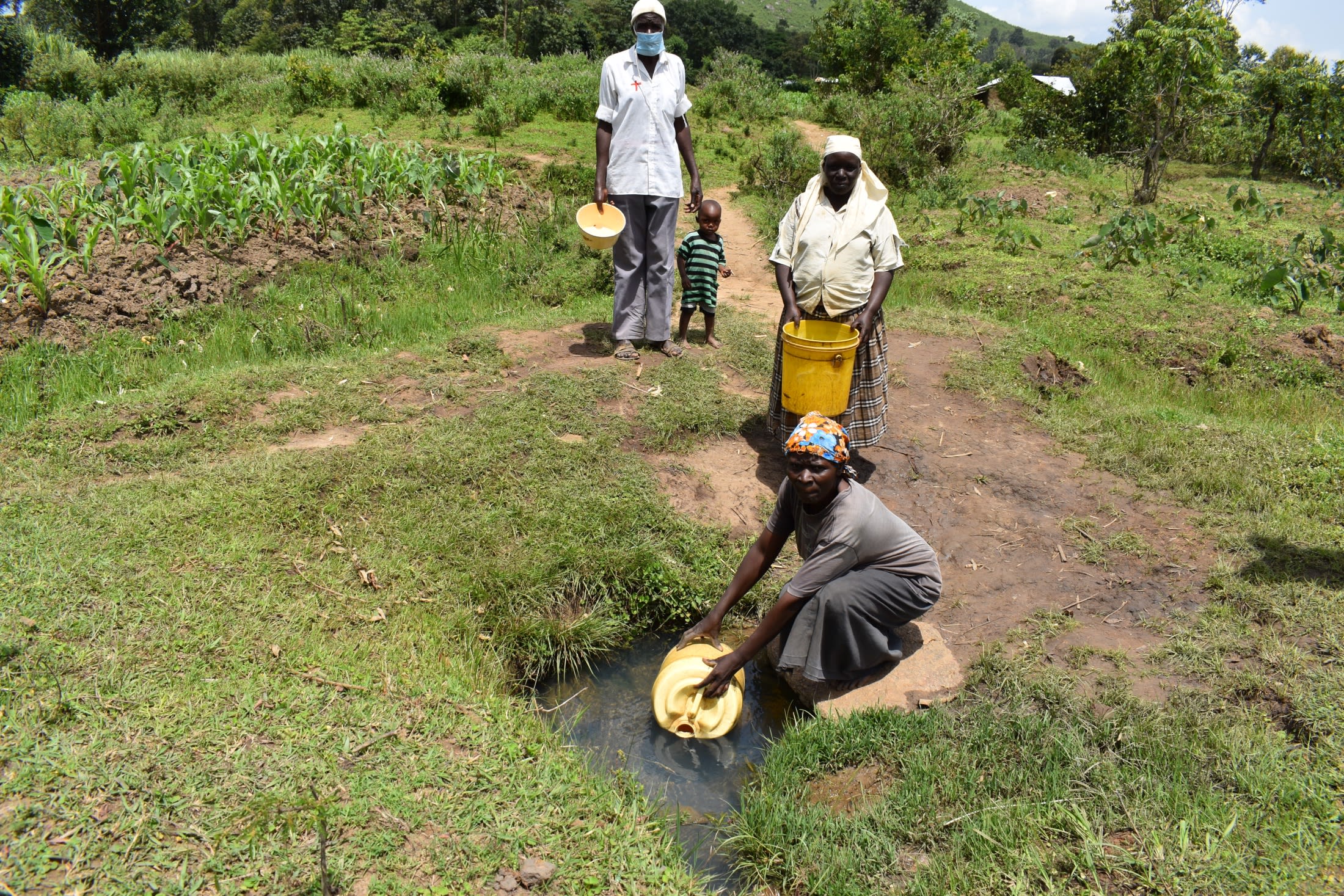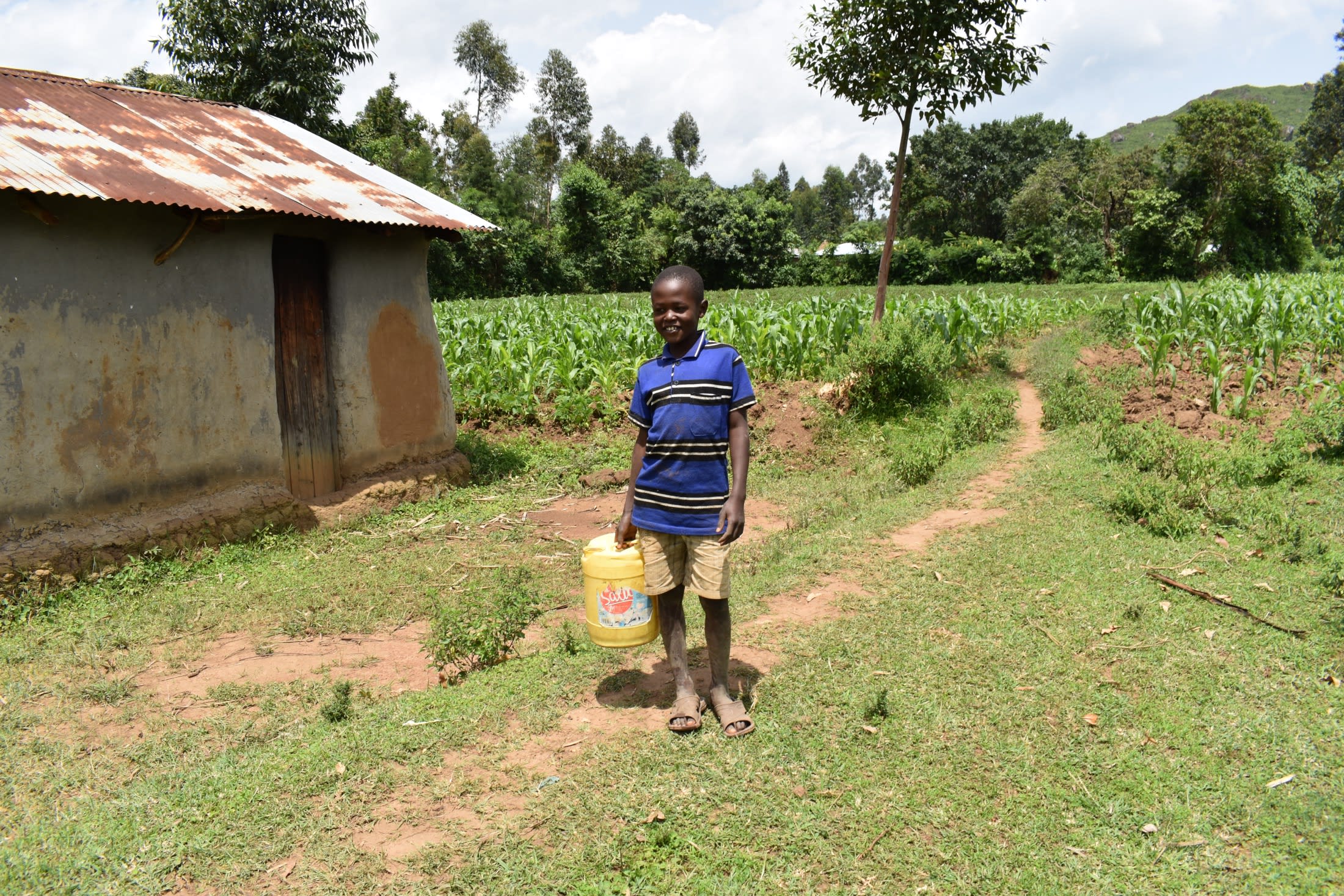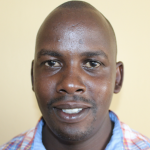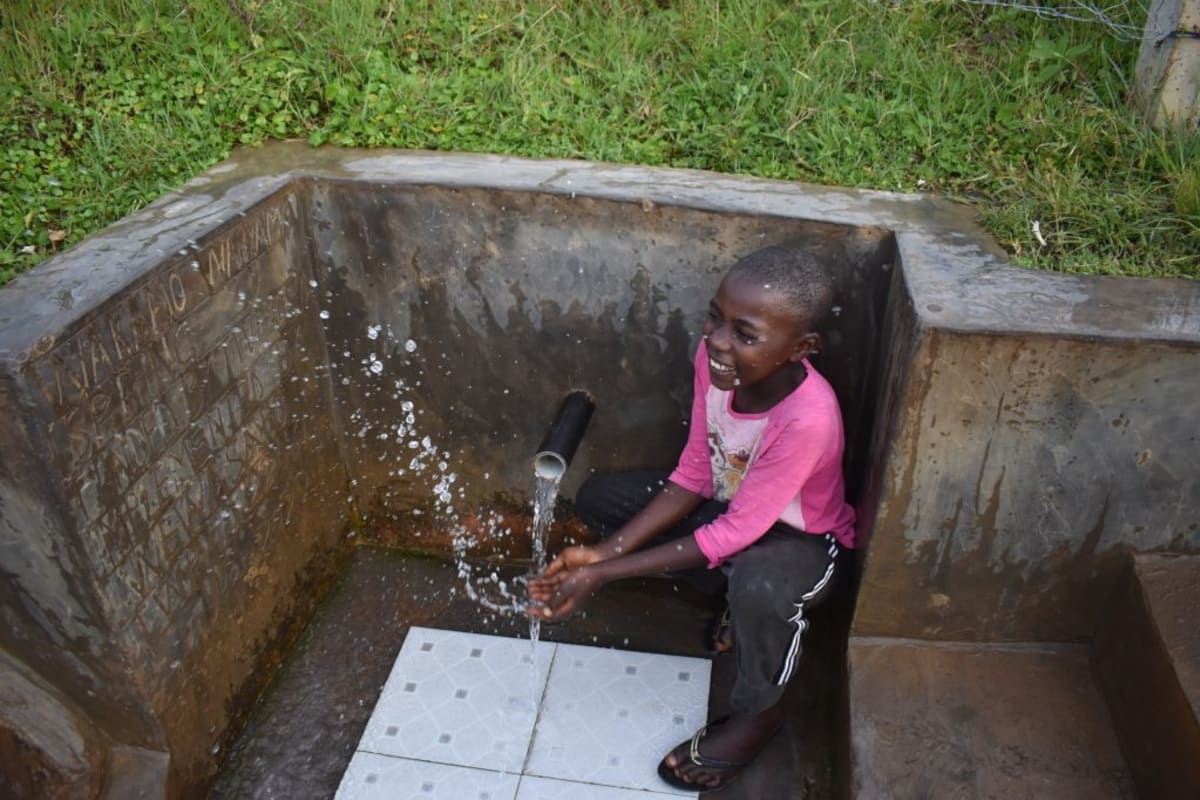September, 2022: Lukhokho Community Spring Protection Complete!
Lukhokho Community now has access to clean water! We transformed Wakamo Wanyama Spring into a flowing source of naturally filtered water thanks to your donation. Our team also trained the community on improved sanitation and hygiene practices. Together, these components will unlock the opportunity for community members to live better, healthier lives.
"The reliability of water from this water point will impact my life positively," said 35-year-old farmer Injendi Shitama. "This is because I will no longer drink contaminated water like before. Additionally, I will no longer waste my time queuing at the water point fetching water, thus spending minimal time, which will help me concentrate on other income-generating activities."

Injendi (left, in the striped shirt) fetches water with other community members.
"My plan is to improve hygiene practices, which used to be very poor," Injendi continued. "I used to wash my clothes only when visitors are visiting me. This is because getting water at this water point sometimes was very challenging, especially during dry spells because the spring serves a lot of people from different villages, which was making the water very dirty. Now that the spring has been protected, I will be able to fetch water anytime."
Children were just as excited as adults about the new waterpoint.
"Firstly, I will be able to drink safe, clean water," said 14-year-old Ester J. "Secondly, I will be able to concentrate on my studies because I will no longer take a lot of time at the spring fetching water, unlike before. I used to fetch water using a jug which [took] a lot of time because I had to be very careful not to contaminate the water."

Ester at the spring.
"My goal is to improve in [my] academic performance and hygiene practices because I will no longer spend a lot of time fetching water, thus saving time," Ester continued. "As an [exam] candidate, I am very much sure that I will greatly improve in my academics. Additionally, I will be able to wash my school uniform twice a week since water is available all the time, and the knowledge acquired in [the] soap-making process will help me a lot."
Preparing for Spring Protection
Community members worked together to source and carry all locally available construction materials to the spring. These included bricks, sand, stones, and fencing poles. Some people also chiseled away at large rocks to break them down into gravel. Because people have to carry most items by hand, the material-collection process can take anywhere from a few weeks to months.
When the community was ready, we sent a lorry to deliver the remaining construction materials, including cement, plastic tarps, and hardware. Then, our construction artisan and field officers deployed to the spring to begin work. Individual households provided meals throughout each day to sustain the work team.
From Open Source to Protected Spring: A Step-by-Step Process
First, we cleared and excavated the spring area. Next, we dug a drainage channel below the spring and several runoff diversion channels above and around the spring. These help to divert surface contaminants away.

To ensure community members could still access water throughout the construction process, we also dug temporary channels from the spring's eye around the construction site. This allowed water to flow without disrupting community members' tasks or the construction work. Excavation created space for setting the spring's foundation, made of thick plastic tarp, wire mesh, concrete, and waterproof cement.

After establishing the base, we started brickwork to build the headwall, wing walls, and stairs. Once the walls had grown tall enough, we began one of the most crucial steps: setting the discharge pipe. The discharge pipe needs to be positioned low enough in the headwall so the water level never rises above the spring's eye, yet high enough to allow room for the average jerrycan (a 20-liter container) to sit beneath the pipe without making contact.

If we place the discharge pipe too high above the spring's eye, backpressure could force water to emerge elsewhere. Too low, and community members would not be able to access the water easily. We embedded the pipe using clay (or mortar when clay is in short supply) and placed it at an incline to ensure water flows in the right direction.
In coordination with brickwork, we pitched stones on both sides of the spring's drainage channel. We then cemented and plastered each stone, forming the rub walls. These walls discourage people and animals from standing in that area, which could cause soil erosion and a clogged drainage area.

We then cemented and plastered both sides of the headwall and wing walls. These finishing layers reinforce the brickwork and prevent water in the reservoir from seeping through the walls. In turn, enough pressure builds in the reservoir box to push water out through the discharge pipe.

As the headwall and wing walls cured, we cemented and plastered the stairs and installed four tiles beneath the discharge pipe. The tiles protect the concrete from the falling water's erosive force while beautifying the spring and facilitating easy cleaning of the spring floor.

The final stage of construction is backfilling the reservoir box behind the discharge pipe. We cleared the collection box of any debris that may have fallen during construction. Then we redirected the temporary diversion channels back into the reservoir box, channeling water into this area for the first time. We closed off all of the other exits to start forcing water through the discharge pipe only.

We filled up the reservoir area with the large, clean stones community members had gathered, arranging them in layers like a well-fitting puzzle. We covered the rocks with a thick plastic tarp to minimize potential contamination sources, then piled enough dirt on top to compensate for future settling.
Community members transplanted grass onto the backfilled soil to help prevent erosion. Finally, the collection area was fenced to discourage any person or animal from walking on it. Compaction can lead to disturbances in the backfill layers and potentially compromise water quality.
The entire construction process took about two weeks of work and patience to allow the cement and plaster to finish curing. As soon as the spring was ready, people got the okay from their local field officers to fetch water.

We officially handed over the spring to mark the community's ownership of the water point. Happiness, thanksgiving, and appreciation were the order of the day, flowing in all directions. Community members said a prayer to bless the spring and thank everyone involved in its creation.
Training on Health, Hygiene, and More
Together with the community, we found their preferred date for training while considering other community calendar events, such as the agricultural season and social events. We requested a representative group of community members to attend training and relay the information learned to the rest of their family and friends.
When the day arrived, facilitators Nelly, Jonathan, and Catherine deployed to the site to lead the event. 20 people attended the training, including 15 women and five men. We held the training under a shade tree near the spring.

We covered several topics, including community participation in the project, leadership and governance, personal and environmental hygiene, water handling and treatment, spring maintenance, dental hygiene, the ten steps of handwashing, disease prevention, and how to make and use handwashing stations.
During the leadership and governance session, we held an election for the newly formed water user committee leaders, who will oversee the maintenance of the spring. We also brainstormed income-generating activities. Community members can now start a group savings account for any future minor repairs to the spring and a cooperative lending group, enabling them to develop small businesses.

When we talked about maintaining the spring, everyone marched to the waterpoint so we could show community members the different parts of the spring and how to care for each. All the members of the community appreciated the fact that Lukhokho's older men wanted to know all the parts and how to maintain them. People posed questions and listened attentively, which was so encouraging to our field officers.
"It was so wonderful to see members of the community working together in order to achieve a common goal of accessing clean and safe water," said field officer Nelly Chebet.
When we covered best handwashing practices, one community member put up a prize of half a kilo of sugar for the first person who could properly perform all the steps of handwashing, which made trying it out very exciting and fun for everyone.

Community members practice handwashing.
"I have acquired knowledge on alternative resources to use in brushing my teeth," said Ester, who was quoted earlier. "It [would] be a lame excuse to fail in brushing my teeth because of a lack of money to buy toothpaste or toothbrush. [This] training has helped me to know that salt, charcoal, and chewed sticks can also aid me to practice dental hygiene in the same manner [as] toothpaste and toothbrush."
While what Ester said may sound incredible to those who are unfamiliar with the practice, studies have shown that using chewing sticks from the locally grown "toothbrush tree" is quite effective. For families who struggle financially, this is a great way to ensure they are still tending to their personal hygiene.

Conclusion
This project required a substantial collaboration between our staff, our in-country teams, and the community members themselves. When an issue arises concerning the spring, the water user committee is equipped with the necessary skills to rectify the problem and ensure the water point works appropriately. However, if the issue is beyond their capabilities, they can contact their local field officers to assist them.
Also, we will continue to offer them unmatchable support as a part of our monitoring and maintenance program. We walk with each community, problem-solving together when they face challenges with functionality, seasonality, or water quality. Together, all these components help us strive for enduring access to reliable, clean, and safe water for this community.
With your contribution, one more piece has been added to a large puzzle of water projects. In our target areas, we’re working toward complete coverage of reliable, maintained water sources within a 30-minute round trip for each community, household, school, and health center. With this in mind, search through our upcoming projects to see which community you can help next!
Thank you for making all of this possible!




 Protected Spring
Protected Spring
 Rehabilitation Project
Rehabilitation Project





































